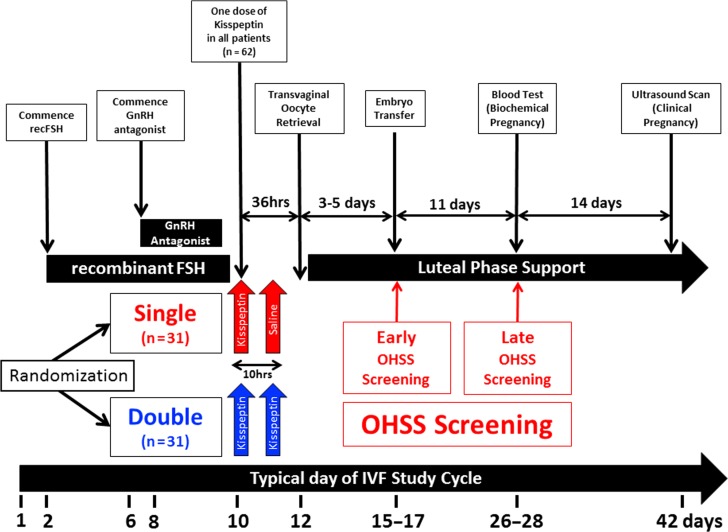Figure 2.
In vitro fertilization study protocol using kisspeptin-54 to trigger oocyte maturation. The timeline shows the day of menstrual cycle for a typical patient. On Day 2 or 3 of the menstrual cycle, daily subcutaneous recombinant FSH (Gonal F 112.5 IU) was commenced. Daily GnRH antagonist injections (Cetrotide 0.25 mg) were commenced after 5 days of recombinant FSH injections. If serum LH was undetectable (<0.5 IU/L) on Day 7 of recombinant FSH injections, the dose of cetrotide was halved to 0.125 mg daily. When at least three ovarian follicles ≥18 mm diameters were visible on ultrasound, all patients (n = 62) received a subcutaneous injection of kisspeptin-54 (9.6 nmol/kg) 36 h prior to oocyte retrieval to trigger oocyte maturation (between 20 :30 and 23:00 h). Injections of GnRH-antagonist and FSH were stopped 24 h and 12 h prior to the first kisspeptin-54 injection, respectively. We have previously shown that this protocol and dose of kisspeptin-54 safely and effectively triggers oocyte maturation in women at high risk of ovarian hyperstimulation syndrome (OHSS) undergoing IVF treatment (Abbara et al., 2015). All patients then received a second injection 10 h after the first injection, but were randomized 1:1 to receive either a second dose of kisspeptin-54 (D; Double, n = 31), or saline (S; Single, n = 31) to determine if a second dose of kisspeptin-54 could increase the duration of LH-exposure and optimize oocyte yield compared to a single dose of kisspeptin-54. Serum reproductive hormones (LH, FSH, estradiol and progesterone) were measured immediately prior to as well as 4 and 10 h after the first kisspeptin-54 injection. Serum reproductive hormones were also measured immediately prior to as well as 4 and 10 h after the second injection (of kisspeptin-54 or saline). Transvaginal ultrasound-directed oocyte retrieval (TVOR) was carried out 36 h following the first kisspeptin-54 injection, and ICSI was performed using fresh sperm from the male partner. If a high quality blastocyst was available, elective single embryo transfer (eSET) was carried out 5 days following oocyte retrieval. Progesterone 100 mg daily intramuscular injections (Gestone, Nordic Pharma, UK) and estradiol valerate 2 mg orally three times daily (Progynova, Bayer, Germany) was commenced from the evening of TVOR until 12 weeks gestation. All women recruited to the study were regarded as being at high risk of OHSS and were routinely screened for the development of early OHSS (assessed on day of embryo transfer 3–5 days after TVOR) and late OHSS (assessed 11 days after embryo transfer). Biochemical pregnancy (serum βHCG > 10 iU/L) was assessed 11 days following embryo transfer and clinical pregnancy was assessed by ultrasonography at 6 weeks gestation.

